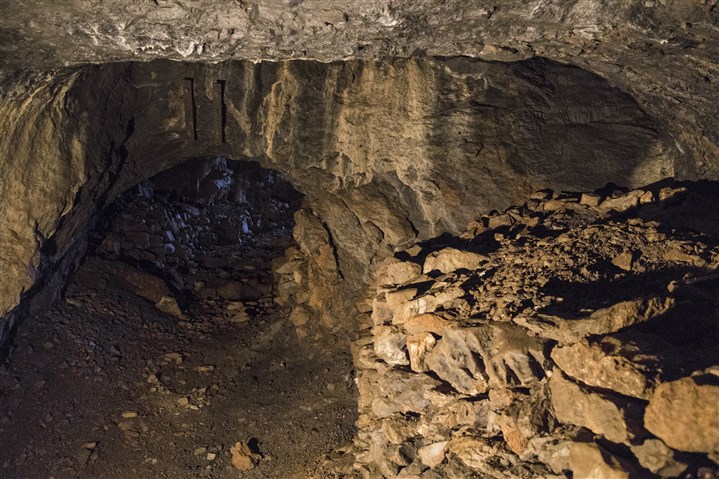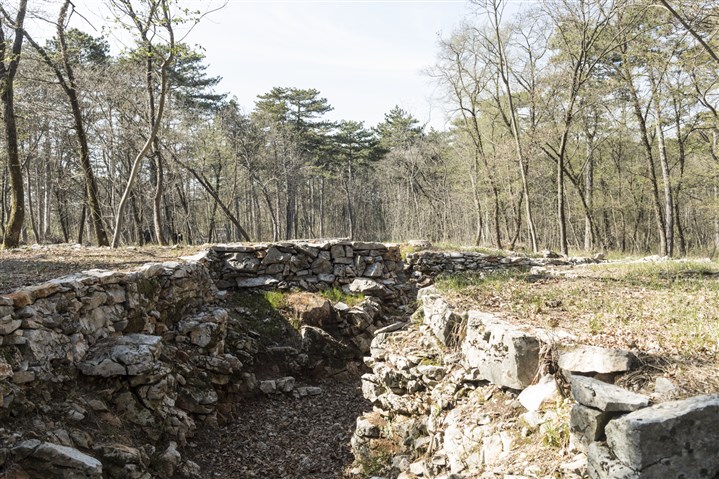Park 97 is a Great War itinerary inaugurated in the summer of 2017 in the (wood) Bosco Fornace in Prosecco (Municipality of Trieste), on the edge of the Karst not far from the well-known Castle of Miramare. The testimonies and relics visible today (thanks to the work of the Committee for the Separate Administration of Prosecco’s civic assets) are very particular compared to those of other open-air museums in Friuli Venezia Giulia. Here there are no trenches, fortifications and other military structures built during the conflict (or in the period immediately before the outbreak of the war), but a series of infrastructures built for the training of soldiers.
The area was designed in the second half of the 19th century and amplified during the Great War with the building of two trenches. The name of the Park refers to the 97th Imperial Royal Austro-Hungarian Regiment, formed by men coming from what was once called Küstenland (Coastland), or Trieste, Istria and what used to be Austrian Friuli. Here the fighting techniques of the era and the use of weapons was taught to those who were enlisted in the 97th I.R. Regiment (but later the Camp was used by the I.R. 20th Special Corps battalion of the Coastline and the Carniola and by the I.R. 5th infantry regiment of territory defence Trieste).

THE INSIDE OF GROTTA PRIAMO, A NATURAL CAVITY TYPICAL OF THE KARST AREA ADAPTED FOR MILITARY PURPOSES. DURING THE CONFLICT MANY CAVES WERE USED FOR MILITARY PURPOSES, ESPECIALLY AS SHELTERS FOR THE SOLDIERS.
The starting point of the visit is at the entrance to Bosco Fornace, which can be reached by car (partially dirt road marked as CAI 1). Here you will find the first totem with an engraved QR Code that allows you to download the fact sheets (each stage has its own specific totem and specific fact sheet).
The path, marked in the first part by the signposts of the Alpe Adria Trail, leads easily to the first stage, or Grotta Priamo, visible on the left a few metres from the main path. Continuing straight ahead, after a few metres, you can observe the first of the five backstop mounds, which resemble small hills nestled in the karst environment. Continuing along the path CAI 1 you reach the second totem where you can see the last backstop mound. From this point, after about 400 metres, you leave the path CAI 1 turning right on the path CAI 19 (this is also part of the Alpe Adria Trail) and then turn right again on a wide dirt road which quickly brings you to the training trench. Once you are out of the trench, continue the visit of the Park along the same road until it bends abruptly to the right. Here there is a small deviation onto an (unmarked) path that detaches to the left and brings you to the last stage of the itinerary, Grotta Bersaglio (to access it follow the path that opens into the wood near the totem with the QRCode). At this point, to go back you have to return to the bend described above to reach the path CAI 1 near the backstop mounds and from there you turn left to go back to the car park.

THE TRAINING TRENCH SEEN FROM THE INSIDE. THE RESTORATION WORK CAN ALLOW EVERYONE TO UNDERSTAND THIS INTERESTING ASPECT WHICH IS OFTEN LITTLE CONSIDERED, NAMELY THE PREPARATION OF SOLDIERS FOR COMBAT AND ASSAULT IN THE TRENCHES.
For those who wish to visit other testimonies of the Great War relating to the Austro-Hungarian army just a few hundred metres away, you can find the Austro-Hungarian Cemetery of Prosecco or the recently inaugurated Park 40 near the Shrine of Mount Grisa (at about 2 km) which is dedicated to the Austro-Hungarian Coastal Trench. A few kilometres away, in the nearby Municipality of Duino Aurisina, you can visit the open-air museum of Mount Ermada and the Austro-Hungarian cemetery of Aurisina.


